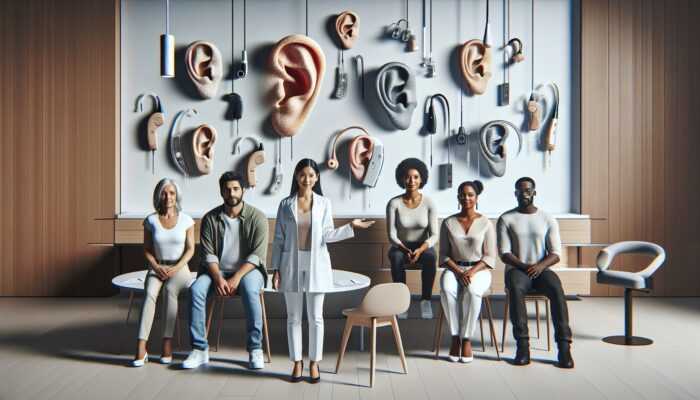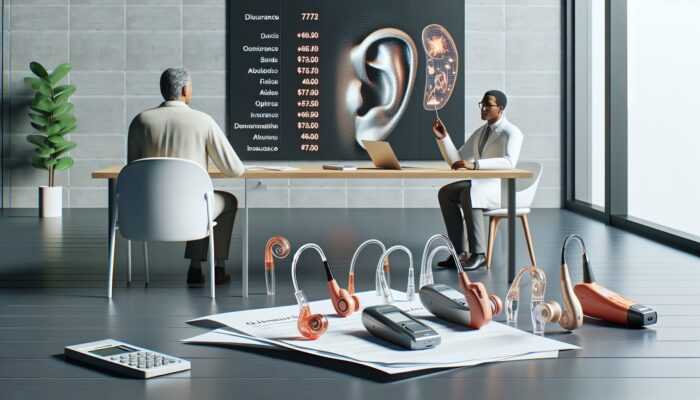Last Updated on 20/06/2025 by Admin
Understanding the Essential Importance of Professional Hearing Assessments in Audiology
Initiating Your Hearing Health Journey with Comprehensive Evaluations

A comprehensive hearing evaluation is paramount as it lays the groundwork for effective audiological services, enabling audiologists to expertly select appropriate hearing aids. This intricate process commences with a thorough patient interview, during which audiologists gather critical information about the patient’s medical history, lifestyle habits, and specific hearing difficulties. Following the collection of this vital data, audiologists conduct an array of diagnostic tests, including pure-tone audiometry and speech recognition assessments, to precisely evaluate the severity and type of hearing loss the patient is experiencing.
With the advent of modern technology, audiologists now utilise advanced diagnostic tools that significantly improve their evaluations. For instance, high-frequency audiometry tests can detect early signs of hearing loss that conventional assessments might miss. The insights gained from these thorough evaluations empower audiologists to devise a tailored treatment plan, ensuring that the selected hearing aids are perfectly suited to each patient’s unique auditory requirements.
Moreover, beyond auditory assessments, initial evaluations also take into account the emotional and psychological effects of hearing loss. Many individuals may experience feelings of isolation or frustration due to their hearing challenges, which can adversely affect their overall mental well-being. By recognising these essential aspects, audiologists can adopt a more holistic approach, assisting patients not only with the technicalities of their hearing impediments but also with the emotional adjustments required as they acclimate to their new hearing aids.
Crafting Individualised Hearing Profiles for Tailored Solutions
The creation of personalised hearing profiles is an integral aspect of audiologists’ responsibilities in the selection of hearing aids. Once initial evaluations are complete, audiologists conduct a meticulous analysis of the results to develop a customised hearing profile that accurately reflects the patient’s distinct auditory strengths and weaknesses. This profile becomes a guiding tool, steering both the audiologist and the patient through the hearing aid selection process, ensuring that the chosen devices align with individual requirements.
The personalisation of hearing solutions transcends merely matching device specifications to the patient’s hearing loss. Audiologists also factor in various elements, including the patient’s daily surroundings, lifestyle choices, and personal preferences. For instance, a business professional regularly attending meetings may require hearing aids that deliver exceptional sound clarity in noisy settings, whereas a retiree who enjoys social gatherings with family may prioritise comfort and ease of use.
Furthermore, with technological advancements, audiologists can develop dynamic hearing profiles that evolve as patients’ hearing needs change over time. As individuals encounter different listening environments or experience variations in their hearing capabilities, audiologists are able to make timely modifications to the hearing aids. This adaptability ensures that patients benefit from the optimal auditory experience throughout their hearing aid journey, highlighting the importance of ongoing collaboration between audiologists and their clients.
Ensuring Long-Term Success with Continuous Monitoring and Adjustments
The selection of hearing aids involves much more than just the initial fitting. Regular follow-up appointments are vital to ensure that the hearing aids continue to align with the patient’s changing needs. These ongoing assessments enable audiologists to evaluate the performance of the devices and ascertain whether any adjustments are necessary. This proactive approach exemplifies audiologists’ roles in hearing aid selection.
During follow-up consultations, audiologists often perform additional evaluations to assess the effectiveness of the hearing aids. They may ask patients about their experiences, including comfort and sound quality in various environments. If patients report any difficulties—such as challenges in noisy situations or discomfort from their devices—audiologists can quickly make necessary adjustments to the settings or recommend alternative models that better meet their needs.
These follow-up appointments also serve as invaluable opportunities for patient education. Audiologists can provide guidance on the maintenance and care of hearing aids, troubleshoot common issues, and address any concerns that may arise. This ongoing support fosters a collaborative relationship, ensuring that patients feel empowered and engaged in their journey towards improved hearing health.
Choosing the Right Hearing Devices to Meet Individual Needs

Diving into the Diverse Range of Hearing Aid Types Available
In the pursuit of suitable hearing aids, audiologists play a crucial role in educating patients about the extensive variety of devices on the market. Each type of hearing aid comes with unique functionalities, benefits, and potential drawbacks. For example, certain devices are specifically designed for individuals with mild to moderate hearing loss, while others cater to those with more severe cases.
Beneath the surface, audiologists evaluate numerous factors, including the degree of hearing loss, the physical condition of the ear, and the patient’s lifestyle preferences. For instance, BTE (Behind-The-Ear) aids are renowned for their durability and extended battery life, making them ideal for active individuals. Conversely, ITE (In-The-Ear) aids provide a more discreet option for those who value aesthetics without compromising sound quality.
Audiologists also stay abreast of the latest developments in hearing aid technology, including features such as Bluetooth connectivity, which allows users to connect their devices with smartphones and other gadgets for an enhanced auditory experience. This expertise empowers audiologists to assist patients in navigating their options effectively, ensuring they select a device that not only meets their hearing needs but also aligns seamlessly with their lifestyle preferences.
Integrating Technology with Lifestyle for Enhanced Hearing Experiences
The process of selecting hearing aids goes beyond mere technological specifications; it requires aligning that technology with the patient’s everyday life. Audiologists excel at matching devices to individual lifestyles, a vital aspect of audiologists’ roles in hearing aid selection. Understanding how patients engage with their surroundings can profoundly influence the type of hearing aids recommended.
For example, a patient who frequently attends concerts or social events may benefit from hearing aids equipped with advanced noise-cancellation technology. These devices can filter out background noise, allowing users to concentrate on conversations without being overwhelmed by surrounding sounds. On the other hand, an individual who leads a quieter lifestyle might prioritise comfort and battery longevity over high-tech features.
Audiologists also consider the patient’s daily routine when recommending supplementary accessories and devices. For instance, an active person may prefer accessories designed for moisture and dirt resistance, while someone who travels frequently might favour lightweight and easily storable hearing aids. By taking the patient’s overall lifestyle into account, audiologists ensure that the chosen hearing aids integrate smoothly into their daily experiences.
Navigating the Complexities of Costs and Insurance for Hearing Aids

Understanding the financial implications of hearing aids can be overwhelming for many patients. Audiologists are pivotal in guiding individuals through this often-confusing landscape, helping them grasp the costs associated with hearing aids and the potential for insurance coverage. This aspect of audiologists’ roles in hearing aid selection is crucial for empowering patients to make informed choices.
The price of hearing aids can fluctuate significantly based on technology, brand, and features. Audiologists clarify these costs by providing patients with a detailed breakdown of what to anticipate. They can also discuss various financing options, including payment plans and potential rebates offered by manufacturers or organisations, making the process more manageable.
Insurance coverage for hearing aids can be inconsistent and perplexing. Audiologists assist patients in deciphering their insurance policies, guiding them through the claims process and helping them understand which costs may be covered. By offering this essential support, audiologists alleviate financial stress, empowering patients to prioritise their hearing health without feeling burdened by costs.
Fitting and Programming: Achieving Optimal Alignment for Hearing Aids
Ensuring a Comprehensive Custom Fit for Maximum Comfort and Performance
Achieving an appropriate fit is one of the most vital steps in the hearing aid selection process. Audiologists utilise their expertise to ensure that hearing aids fit comfortably and securely within the patient’s ear. This careful fitting procedure not only enhances the user’s overall experience but is also crucial for optimal sound quality—an essential element of audiologists’ roles in hearing aid selection.
During the fitting process, audiologists measure the size of the patient’s ear canals and create moulds if necessary. This level of personalisation is particularly important for ITE devices, which require precise measurements to ensure a comfortable fit. A well-fitted hearing aid reduces feedback and enhances sound transmission, enabling patients to enjoy clearer audio.
The fitting procedure also encompasses the selection of ear tips, which can enhance both comfort and sound quality. Audiologists present patients with various options, considering factors such as ear shape and sensitivity. This meticulous attention to detail ensures that patients not only appreciate the aesthetics of their hearing aids but also experience a significant improvement in their auditory capabilities.
Maximising Efficiency Through Expert Programming of Hearing Aids
Each patient’s hearing profile is unique, and the programming of hearing aids must reflect this individuality. Audiologists are trained to fine-tune the settings of hearing aids to optimise their performance based on the patient’s specific auditory requirements. This aspect is crucial to audiologists’ roles in hearing aid selection.
Programming involves adjusting various parameters, including volume levels, frequency responses, and noise reduction settings, to cater to different listening environments. For example, a patient may require different settings for quiet home environments compared to bustling public spaces. Audiologists employ advanced software and tools to execute these adjustments, ensuring each hearing aid is tailored to maximise the user’s listening experience.
Moreover, advancements in technology have led to the development of programmable hearing aids that allow for real-time adjustments. Audiologists can modify settings remotely, providing convenience for patients and ensuring that their hearing aids remain effective as their needs evolve over time.
Empowering Patients Through In-Depth Education and Training
A key aspect of the fitting and programming process is patient education. Audiologists dedicate time to instruct patients on how to effectively utilise and maintain their hearing aids. This step is foundational to audiologists’ roles in hearing aid selection and ensures that patients feel assured and empowered in their hearing journey.
During training sessions, audiologists explain the various functionalities of the hearing aids, including operating instructions and the importance of regular maintenance. Patients acquire essential skills such as battery replacement, cleaning procedures, and troubleshooting common issues. This educational approach demystifies the technology, making it more accessible and user-friendly.
Furthermore, audiologists encourage patients to engage by asking questions and voicing concerns. This open line of communication cultivates a cooperative relationship, allowing audiologists to tailor their education to meet the specific needs and preferences of each individual. By equipping patients with the necessary knowledge and skills, audiologists empower them to thrive in their hearing health journey.
The Significance of Follow-Up Appointments for Continued Care
Follow-up appointments play a crucial role in the hearing aid journey, reinforcing audiologists’ roles in hearing aid selection. These visits allow audiologists to assess how well the hearing aids are functioning for the patient and to make necessary adjustments. Regular check-ins ensure that patients remain satisfied with their devices and that their hearing needs are consistently met.
During follow-up visits, audiologists often conduct additional assessments to evaluate the performance of the hearing aids. They may seek feedback from patients regarding sound quality, comfort, and functionality. If patients encounter challenges or express concerns, audiologists can promptly address these issues, whether through minor adjustments or by exploring alternative devices.
These appointments also present opportunities for ongoing education. Audiologists can share tips on optimising hearing aid usage, inform patients about new research or advancements in technology, and emphasise the importance of continuous hearing health monitoring. This dedication to patient care extends well beyond the initial fitting, ensuring that patients receive the support they need throughout their hearing journey.
Resolving Common Challenges Associated with Hearing Aids
Despite the sophisticated technology available today, patients may still face challenges while using their hearing aids. Audiologists are well-equipped to address these common issues, which is a critical aspect of audiologists’ roles in hearing aid selection. By providing troubleshooting support, audiologists help patients navigate potential problems, ensuring they can continue to enjoy the benefits of their devices.
Common challenges may include sound distortion, feedback, or discomfort. Audiologists guide patients in identifying the source of these issues and recommending effective solutions. For instance, if a patient experiences feedback, the audiologist might suggest adjustments to the fit or settings of the device.
Additionally, audiologists offer valuable maintenance tips, ensuring that patients grasp the importance of regular cleaning and care for their hearing aids. This proactive approach helps mitigate potential problems and extends the lifespan of the devices, ultimately enhancing user satisfaction and experience.
Addressing Patient Concerns to Enhance Overall Satisfaction
Establishing Realistic Expectations for Hearing Aids
One of the most important elements of the patient-audiologist relationship is managing expectations regarding hearing aids. Audiologists play a critical role in helping patients understand what they can realistically expect from their devices, a core aspect of audiologists’ roles in hearing aid selection.
Many patients enter the process with preconceived notions or misconceptions about hearing aids. Audiologists must clarify that while modern technology has advanced significantly, hearing aids are not a cure for hearing loss. Rather, they are tools designed to enhance hearing, and the adjustment period may vary for each individual. Audiologists can support patients throughout this transition, emphasising the need for patience and regular adjustments as they adapt to their new auditory experience.
Furthermore, discussing the limitations of hearing aids is equally essential. For example, patients should be made aware that certain environments, particularly those with considerable background noise, may still present challenges. By establishing realistic expectations, audiologists help patients concentrate on the positive aspects of their hearing aids and appreciate the improvements they contribute to their quality of life.
Offering Solutions for Common Hearing Aid Challenges
As patients embark on their journey with hearing aids, they may encounter various challenges. Audiologists serve as invaluable resources for troubleshooting these common issues, further reinforcing audiologists’ roles in hearing aid selection. By providing practical solutions and support, audiologists assist patients in effectively navigating these obstacles.
Common issues may range from difficulties with sound clarity to device comfort and battery performance. Audiologists help patients identify the root causes of these problems and offer actionable solutions. For instance, if a patient reports that sounds seem muffled, the audiologist may recommend a check-up to adjust the device’s settings or ensure that filters are clean.
Audiologists also educate patients on common maintenance practices that can prevent potential issues, including keeping hearing aids dry and avoiding exposure to extreme temperatures. This knowledge empowers patients to take proactive measures in their hearing health, ensuring that their devices function optimally.
Providing Emotional and Psychological Support Throughout the Hearing Journey
The process of adapting to hearing aids can evoke a range of emotional and psychological responses in patients. Audiologists recognise the importance of offering emotional support as part of audiologists’ roles in hearing aid selection. By addressing the psychological aspects of hearing loss, audiologists can deliver a more comprehensive approach to patient care.
Many individuals may experience feelings of anxiety or embarrassment regarding their hearing loss, which can lead to reluctance in seeking assistance. Audiologists strive to create a welcoming and supportive environment where patients feel comfortable voicing their concerns. By actively listening and validating their emotions, audiologists empower patients to embrace their hearing aids as essential tools for enhancing their quality of life.
Additionally, audiologists can connect patients with support groups or resources that promote community and understanding. These networks allow patients to share experiences, learn from one another, and reduce feelings of isolation. This comprehensive support system not only aids in the adjustment process but also encourages patients to remain proactive in their hearing health journey.
Investigating Technological Advancements in Audiology
Groundbreaking Innovations Transforming Hearing Aids
In the rapidly evolving landscape of audiology, keeping pace with the latest innovations in hearing aids is essential for audiologists. The introduction of advanced technologies has greatly enhanced audiologists’ roles in hearing aid selection, facilitating tailored solutions that cater to the diverse needs of patients globally.
Recent innovations include hearing aids featuring artificial intelligence (AI), which can adapt to the user’s listening environment in real-time. This technology allows devices to automatically adjust volume levels and filter background noise, thereby improving the clarity of conversations. Furthermore, many modern hearing aids offer connectivity options, enabling users to stream audio directly from their smartphones, televisions, or other devices, enriching their auditory experiences even further.
Another significant advancement is the development of rechargeable hearing aids, which eliminate the inconvenience of frequent battery replacements. This convenience is particularly appealing to active individuals who want to ensure their devices are always ready for use. By integrating these innovations into their practice, audiologists can provide patients with cutting-edge solutions that enhance their hearing capabilities and overall satisfaction.
Seamless Integration with Other Technologies for Enhanced Experiences
The integration of hearing aids with other technologies marks a notable trend in audiology, reinforcing audiologists’ roles in hearing aid selection. This capability allows users to experience seamless connections with their preferred technologies, significantly enhancing their daily auditory experiences.
For example, many contemporary hearing aids are equipped with Bluetooth technology, enabling users to connect their devices directly to smartphones, televisions, and computers. This feature facilitates hands-free phone calls, direct streaming of music or podcasts, and even the ability to adjust settings via mobile applications. Such connectivity not only enhances convenience but also fosters independence, allowing users to personalise their listening experiences according to their specific requirements.
Audiologists are essential in guiding patients through this technological landscape. They educate users on the various integration options available, demonstrating how to establish connections and troubleshoot potential issues. By doing so, audiologists help patients maximise the benefits of these integrated features, significantly improving their overall quality of life.
Anticipating Future Trends in Audiology for Enhanced Patient Care
As the field of audiology continues to evolve, it is crucial for audiologists to anticipate future trends and developments. Innovations are emerging at an accelerated pace, reshaping audiologists’ roles in hearing aid selection and enhancing patient care.
One promising trend is the ongoing miniaturisation of hearing aid technology. As devices become smaller and more discreet, patients can enjoy improved aesthetics without sacrificing performance. This trend is particularly attractive to younger individuals and those who prefer a low-profile solution.
Additionally, the integration of telehealth services within audiology practice is gaining traction. Telehealth allows audiologists to conduct remote consultations and follow-up appointments, making hearing care more accessible to patients worldwide. This shift can significantly enhance patient engagement, especially for those in remote areas where access to audiology services may be limited.
As audiologists embrace these future trends, they will continue to play a critical role in ensuring that patients receive the latest advancements tailored to their unique requirements. By remaining informed and proactive, audiologists can offer cutting-edge solutions that empower individuals to enhance their hearing health effectively.
The Transformative Impact of Artificial Intelligence on Hearing Aids
Artificial intelligence is revolutionising the field of audiology, greatly enhancing the functionality and personalisation of hearing aids. The integration of AI into hearing devices signifies a pivotal shift in audiologists’ roles in hearing aid selection, allowing for a more tailored approach to patient care.
AI-driven hearing aids can analyse a user’s listening environment in real-time, automatically adjusting settings to optimise sound quality. For instance, if a user enters a noisy restaurant, the AI can enhance speech recognition while minimising background noise, providing a seamless auditory experience. This level of personalisation was previously unattainable, offering patients a significant upgrade in their hearing experience.
Moreover, AI can track user behaviour and preferences over time, enabling hearing aids to learn and adapt to individual needs. This intelligent technology can even provide insights into hearing health trends, allowing audiologists to make informed decisions during follow-up appointments. By harnessing the power of AI, audiologists can enhance the overall effectiveness of hearing aids, ensuring that patients receive the highest quality care.
As AI continues to advance, its impact will only grow, providing audiologists with innovative tools to enhance their practice and improve patient outcomes. This technological evolution reinforces the importance of the audiologist’s role in guiding patients through their hearing health journey.
Collaboration Across Professions in Audiology
Partnering with ENT Specialists for Comprehensive Hearing Care
Collaboration is vital in the field of audiology, with one of the most significant partnerships being between audiologists and ear, nose, and throat (ENT) specialists. This teamwork enhances audiologists’ roles in hearing aid selection by facilitating comprehensive patient care.
ENT specialists play a crucial role in diagnosing and treating medical conditions that may impact hearing. By collaborating closely with audiologists, they ensure that patients receive a holistic approach to their hearing health. For instance, if an ENT specialist identifies a medical issue contributing to hearing loss, they can work alongside the audiologist to create a treatment plan that incorporates hearing aids as part of the solution.
Regular communication between audiologists and ENT specialists guarantees that patients receive timely referrals and follow-up care. This interdisciplinary approach not only improves patient outcomes but also enhances the overall experience, simplifying the navigation process for patients in the often-complex realm of hearing health.
Collaborating with Hearing Aid Manufacturers for Optimal Solutions
Audiologists frequently establish partnerships with hearing aid manufacturers to stay updated on the latest products and technological advancements. These collaborations play a crucial role in audiologists’ roles in hearing aid selection, enabling them to provide patients with the most effective and innovative devices available.
By maintaining relationships with manufacturers, audiologists gain access to the latest product details, training, and support. This knowledge equips them to recommend devices that best meet their patients’ unique needs. Furthermore, these partnerships can facilitate hands-on workshops and training sessions, allowing audiologists to gain experience with new technologies before they become widely accessible.
Such collaborations also empower audiologists to advocate for their patients in discussions with manufacturers. They can relay feedback from users, highlighting areas for improvement or features that could enhance the user experience. This open dialogue fosters a collaborative environment, ultimately benefiting patients by ensuring they receive the best possible care and access to cutting-edge technology.
Implementing an Interdisciplinary Approach to Enhance Patient Care
An interdisciplinary approach to audiology involves collaboration among various healthcare professionals, including speech therapists and general practitioners. This teamwork strengthens audiologists’ roles in hearing aid selection by creating a more comprehensive care model for patients.
For instance, individuals with hearing loss may also face speech and language challenges. By collaborating with speech therapists, audiologists can ensure that patients receive holistic support addressing both auditory and communicative needs. This integrated approach enhances the effectiveness of hearing aids, as patients learn strategies to maximise their use in everyday conversations.
Additionally, interdisciplinary collaboration can lead to improved patient outcomes. When healthcare professionals communicate effectively and share information, they can develop unified treatment plans that consider all aspects of a patient’s health. This holistic framework not only enhances the quality of care but also fosters a supportive environment where patients feel empowered and engaged in their healthcare journey.
Ethical and Legal Responsibilities in Audiology Practice
Upholding Professional Standards in Audiology Practice
Audiologists are guided by a set of professional standards and ethical guidelines that govern their practice. Adhering to these standards is essential for maintaining the integrity of audiologists’ roles in hearing aid selection and ensuring that patients receive high-quality care.
These standards underscore the importance of evidence-based practice, requiring audiologists to remain informed about the latest research and advancements in the field. This commitment enhances their expertise and enables them to offer patients accurate information and effective treatment options.
Moreover, ethical guidelines dictate that audiologists prioritise their patients’ well-being above all else. This principle informs their decision-making processes, ensuring that patient interests are at the forefront of every recommendation. By adhering to professional standards, audiologists build trust with their patients, fostering a strong therapeutic alliance that enhances the overall care experience.
Securing Informed Consent and Respecting Patient Rights
Informed consent is a fundamental principle in healthcare, and audiologists are responsible for ensuring that patients fully comprehend their treatment options. This facet of audiologists’ roles in hearing aid selection highlights the significance of patient autonomy and informed decision-making.
Before recommending hearing aids, audiologists provide patients with comprehensive information about the devices, including their benefits, limitations, and potential risks. This transparent communication empowers patients to make informed choices that align with their needs and preferences.
Furthermore, audiologists must respect patient rights throughout the treatment process. This includes safeguarding patient confidentiality and ensuring that individuals feel comfortable discussing their concerns and preferences. By prioritising informed consent and patient rights, audiologists foster a collaborative environment where patients feel valued and respected.
Maintaining Confidentiality and Data Protection Standards
Protecting patient information is a critical responsibility for audiologists. Ensuring confidentiality is paramount in maintaining trust and integrity in audiologists’ roles in hearing aid selection.
Audiologists must adhere to stringent regulations regarding data protection, including safeguarding sensitive patient information and maintaining secure records. By implementing robust data protection measures, audiologists can ensure that patient information remains confidential, fostering a sense of security and trust.
Moreover, audiologists must educate patients about their rights regarding data privacy. This transparency empowers individuals to understand how their information is utilised and shared, reinforcing the importance of ethical practices within the field of audiology.
Compliance with Legal Regulations in Audiology Practice
Compliance with legal regulations is an essential aspect of audiology practice. Audiologists must navigate a complex landscape of laws and regulations that govern their profession, ensuring that they adhere to both local and international standards. This compliance is a critical element of audiologists’ roles in hearing aid selection, as it safeguards patient rights and ensures high-quality care.
Legal regulations encompass various aspects, including licensing requirements, scope of practice, and the ethical provision of services. By staying informed about these regulations, audiologists can ensure that their practice remains compliant, thereby protecting themselves and their patients.
Additionally, compliance with legal regulations fosters accountability within the field of audiology. When audiologists adhere to established standards, they contribute to the overall credibility and professionalism of their profession, ensuring that patients receive the highest level of care.
Making Ethical Decisions in Audiology Practice
Ethical decision-making is a cornerstone of audiology practice, guiding audiologists in their interactions with patients and colleagues. This facet of audiologists’ roles in hearing aid selection is crucial for ensuring that patient care is delivered ethically and responsibly.
Audiologists often face complex situations that necessitate careful consideration of ethical principles. For instance, they must balance patient autonomy with professional recommendations, ensuring that patients feel empowered while also receiving expert guidance. This delicate balance is essential for fostering trust and collaboration within the therapeutic relationship.
Furthermore, audiologists must remain vigilant in identifying and addressing potential ethical dilemmas, whether related to patient care, professional conduct, or interactions with industry stakeholders. By engaging in continuous ethical reflection and discussions, audiologists can uphold the highest standards of practice, ensuring that they act in the best interests of their patients.
Commitment to Lifelong Learning and Professional Development
Staying Informed with Cutting-Edge Research and Developments
In the rapidly evolving field of audiology, remaining current with the latest research is vital for audiologists. This commitment to continuous learning enhances audiologists’ roles in hearing aid selection, ensuring that they can provide patients with the most effective and evidence-based solutions.
Audiologists are encouraged to engage in ongoing education through various avenues, including workshops, conferences, and professional journals. By actively participating in these opportunities, they remain informed about the latest advancements in hearing technology, diagnostic techniques, and treatment approaches.
Moreover, keeping abreast of research enables audiologists to critically evaluate new products and technologies before recommending them to patients. This evidence-based approach ensures that patients receive the highest quality care and access to cutting-edge solutions that meet their unique needs.
Engaging in Professional Development Workshops and Conferences
Participating in workshops and conferences constitutes a valuable component of professional development for audiologists. These events provide opportunities for networking, collaboration, and learning from industry experts. By attending workshops and conferences, audiologists can enhance their knowledge and skills, reinforcing audiologists’ roles in hearing aid selection.
Workshops often focus on specific areas of audiology, such as new assessment techniques or advancements in hearing aid technology. Audiologists gain hands-on experience and practical insights that they can immediately apply in their practice. Moreover, conferences offer platforms for sharing research findings, discussing best practices, and exploring innovative approaches to patient care.
By engaging in these professional development opportunities, audiologists cultivate a culture of lifelong learning within their practice, ultimately benefiting their patients through enhanced care and support.
Understanding Certification and Licensing Requirements in Audiology
Maintaining certification and licensing is fundamental for audiologists to practice legally and ethically. Compliance with these requirements is a crucial aspect of audiologists’ roles in hearing aid selection, ensuring that they uphold professional standards and provide high-quality care.
Certification and licensing requirements vary by region, but they typically encompass educational qualifications, continuing education mandates, and examinations. By meeting these criteria, audiologists demonstrate their commitment to maintaining their knowledge and expertise in the field.
Furthermore, adherence to certification and licensing requirements enhances the credibility of audiologists within the healthcare community. Patients are more likely to trust practitioners who are committed to ongoing education and have met rigorous standards, further reinforcing the importance of staying current in the field.
Frequently Asked Questions (FAQs) about Audiology and Hearing Aids
What qualifications are necessary to become an audiologist?
Audiologists typically require a Doctor of Audiology (Au.D.) degree, which includes extensive training in hearing science, diagnostics, and hearing aid selection. Many countries also mandate licensure or certification to practice.
How do audiologists assess the extent of hearing loss?
Audiologists evaluate hearing loss through a series of comprehensive tests, including pure-tone audiometry, speech recognition assessments, and tympanometry, to determine the type and severity of hearing loss.
What factors influence the selection of hearing aids?
Factors influencing hearing aid selection include the type and degree of hearing loss, the patient’s lifestyle, personal preferences, and budgetary considerations. Audiologists tailor their recommendations based on these essential aspects.
How frequently should I have my hearing aids checked?
It is advisable to have your hearing aids evaluated at least once a year or sooner if you notice changes in your hearing or experience issues with the devices. Regular follow-ups ensure optimal performance.
Can hearing aids assist with tinnitus management?
Yes, hearing aids can help manage tinnitus by amplifying external sounds, which may effectively mask the perception of ringing or buzzing in the ears. Audiologists can provide personalised solutions for tinnitus management.
Are there various styles of hearing aids available?
Yes, there is a variety of hearing aid styles, including Behind-The-Ear (BTE), In-The-Ear (ITE), and Completely-In-Canal (CIC). Each style possesses unique features and benefits tailored to different needs.
How should I care for my hearing aids?
Caring for hearing aids involves regular cleaning, ensuring they remain dry, replacing batteries as necessary, and storing them safely. Audiologists provide specific maintenance tips tailored to each device.
What can I expect during a hearing aid fitting?
During a hearing aid fitting, an audiologist will assess the fit and comfort of the devices, program them according to your hearing profile, and provide instructions on usage and maintenance.
What is the typical lifespan of hearing aids?
Hearing aids generally last around 3-7 years, depending on usage and maintenance practices. Regular check-ups can help extend their lifespan and ensure optimal performance.
What are the costs associated with hearing aids?
Costs for hearing aids can vary widely based on brand, technology, and features. Audiologists can guide patients through financing options and insurance coverage to effectively manage expenses.
Explore our world on X!
The post Audiologists and Their Role in Choosing Hearing Aids appeared first on The Microsuction Ear Wax Removal Network.
















